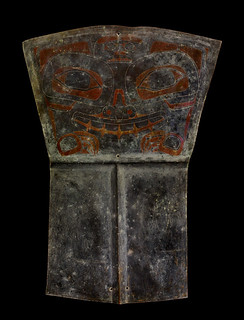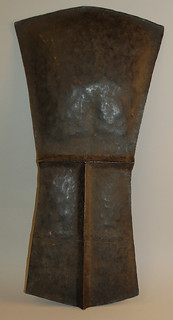
PREV ARTICLE
NEXT ARTICLE
FULL ISSUE
PREV FULL ISSUE
POTLATCH COPPERSArthur Shipee forwarded a great article from the October 1, 2014 British Museum
blog about Potlatch coppers from the American northwest. Thanks! -Editor
Potlatch coppers: wealth and power on the Northwest Coast
 
Two potlatch coppers acquired by the British Museum Last year I began a Collaborative Doctoral Award at the British Museum and UCL studying Native American material culture, having worked for the Americas section of the Department of Africa, Oceania and the Americas at the Museum since 2008. In this post I want to introduce two new acquisitions that help the Museum illustrate the complex wealth-exchange systems of the North Pacific coast of North America. At times of celebration, the wealthiest and most powerful chieftains among the tribes of the Northwest Coast would hold great ceremonial events, known as potlatches. These occasions could last several days, featuring a series of expansive feasts accompanied by dancing, singing and the telling of ancestral stories in the chieftain’s plank-built longhouse. During the potlatch, open negotiations over hunting territories and trading rights would be conducted, the host demonstrating his power and wealth by ostentatious demonstrations of disregard for danger. The anthropologist Franz Boas describes an event that took place among the Kawkwaka’wakw: When a person gives a grease feast, a great fire is lighted at the centre of the house. The flames leap up to the roof and the guests are almost scorched by the heat. Still the etiquette demands that they do not stir, else the host’s fire has conquered them. Even when the roof begins to burn and the fire attacks the rafters, they must appear unconcerned. The host alone has the right to send a man up to the roof to put out the fire. At the climax of the event the host would address his guests in a ceremony centred on the distribution of lavish presents. Most significant of all gifts would be large sheets of shield-shaped copper decorated in a variety of tribal crests. These objects are known by various names: tináa to the Tlingit, t’agu to the Haida and collectively in English as ‘coppers’. Often individually named with complex life-histories, coppers carried a nominal value measured in blankets or slaves, but their importance lay primarily in the obligation they placed on the recipients as part of a network of wealth and power distribution. To the people of the Northwest Coast, copper was an exotic item, originally traded from the north and later with Europeans. It held supernatural properties, and to present a guest with a copper or a piece from a broken copper placed on them a powerful obligation. A host who had received coppers from his guests at their potlatches was compelled to present them with a greater value of coppers than he had previously received and thus obliged his guests to present coppers of even greater value at their next potlatch. The wealthiest chieftains would even smash coppers or throw them into the sea to demonstrate their superiority and strength. A leader who could not afford to make these presents or did not possess coppers could not hold a successful potlatch to celebrate important events and would consequently be considered a man of little importance among his peers. In the late 19th century, colonial authorities saw the potlatch as a dangerous, wasteful and subversive event and sought to stamp it out. It was outlawed in Canada in 1884 and in 1921 Dan Cranmer’s potlatch at 'Mimkwa_mlis (Village Island) was raided by the local police who seized and confiscated hundreds of items of regalia. Potlatching did not cease, but it was forced underground, becoming invisible to the authorities as the regalia which supported it was gradually dispersed to museums and private collections around the world. Since the removal of the anti-potlatch laws in 1951 however, potlatching has once again become a prominent part of life for the people of the North Pacific. To read the complete article, see:
Wayne Homren, Editor The Numismatic Bibliomania Society is a non-profit organization promoting numismatic literature. See our web site at coinbooks.org. To submit items for publication in The E-Sylum, write to the Editor at this address: whomren@gmail.com To subscribe go to: https://my.binhost.com/lists/listinfo/esylum All Rights Reserved. NBS Home Page Contact the NBS webmaster 
|